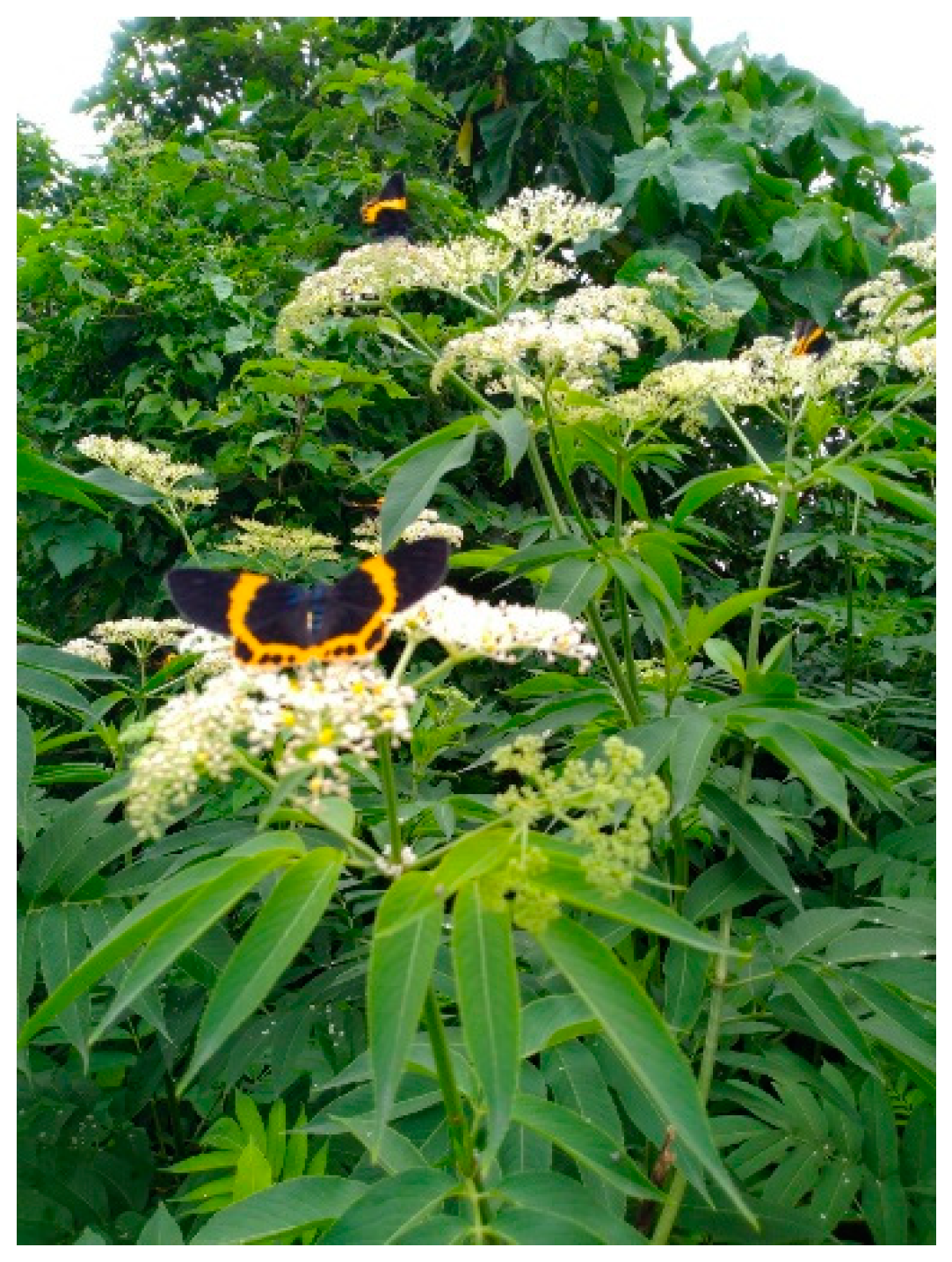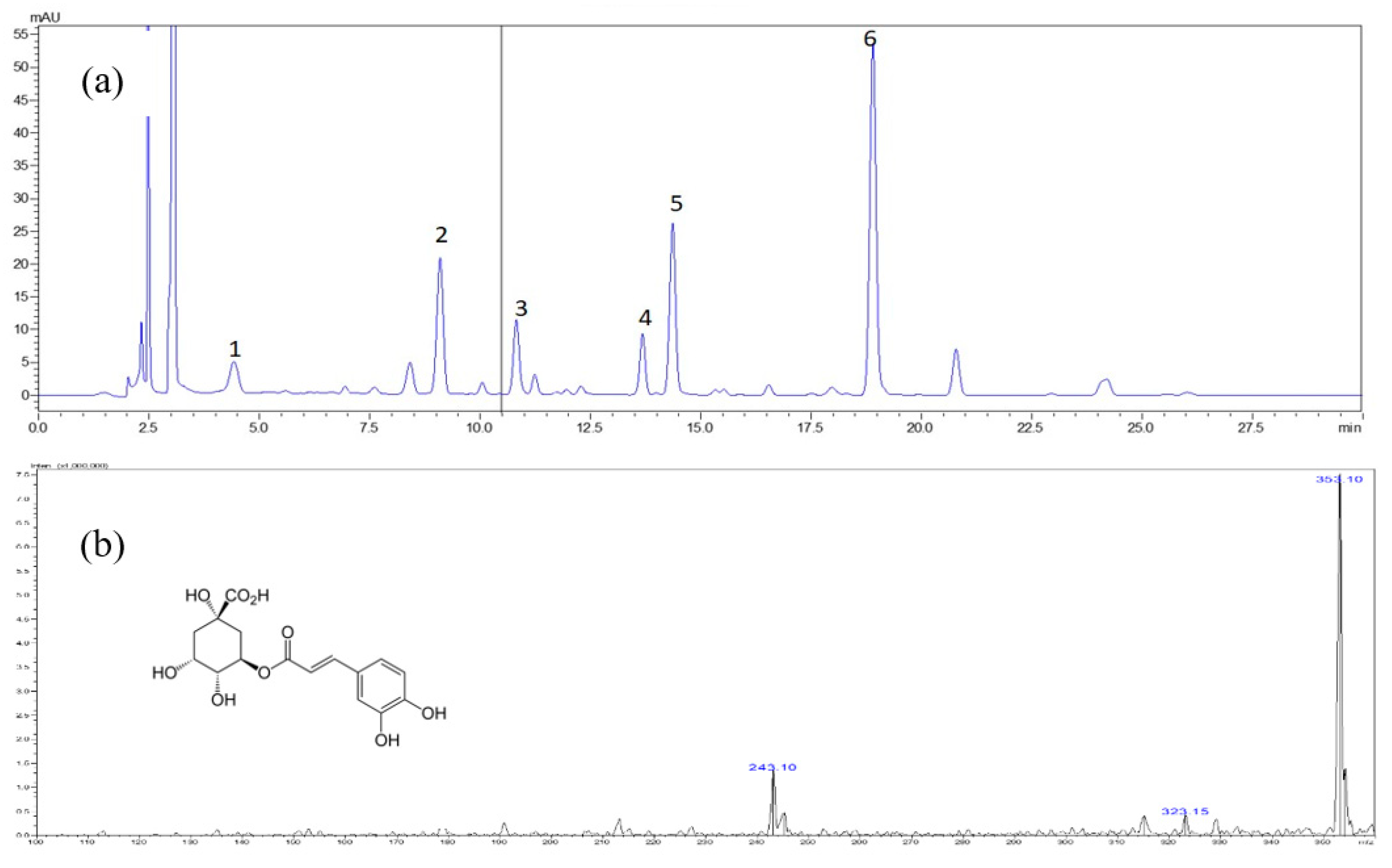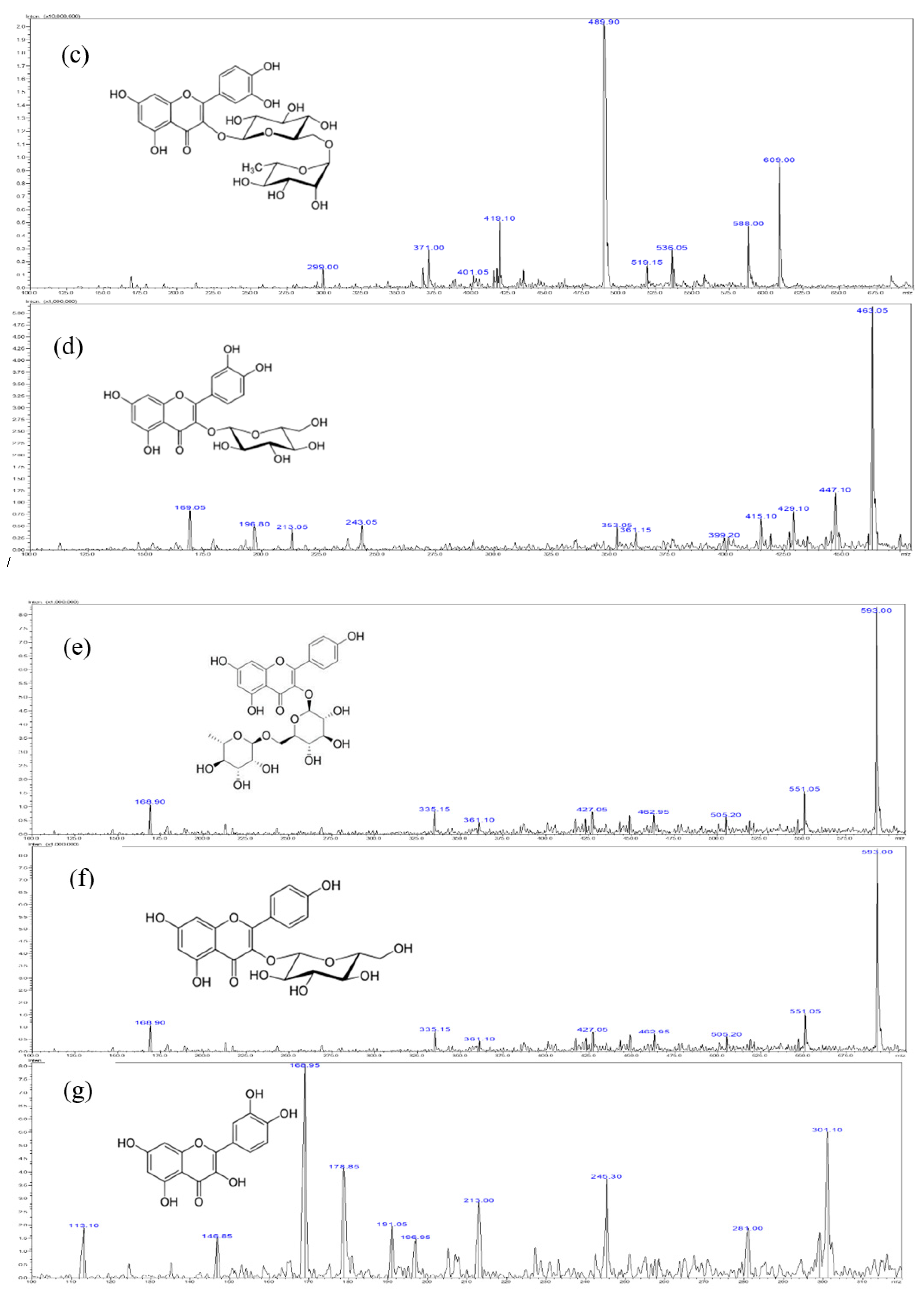HPLC-DAD-ESI-MS Analysis for Simultaneous Quantitation of Phenolics in Taiwan Elderberry and Its Anti-Glycation Activity
Abstract
1. Introduction
2. Results and Discussion
2.1. Analysis of Polyphenolic Compounds by High-Performance Liquid Chromatography–Diode Array Detection–Electro-Spray Ionization Mass Spectrometry (HPLC-DAD-ESI (+)-MS)
2.2. The Content of Total Polyphenols and Antioxidant Activity
2.3. Anti-Glycation Activity
3. Materials and Methods
3.1. Reagents
3.2. Plant Collection and Identification
3.3. Preparation of Extract and Fractions
3.4. HPLC–DAD-ESI-MS Analysis of the Extract
3.5. Determination of Total Polyphenol Content
3.6. DPPH Radical Scavenging Activity
3.7. In Vitro Anti-Glycation Assay
3.8. Statistical Analysis
4. Conclusions
Author Contributions
Funding
Acknowledgments
Conflicts of Interest
References
- Veberic, R.; Jakopic, J.; Stampar, F.; Schmitzer, V. European elderberry (Sambucus nigra L.) rich in sugars, organic acids, anthocyanins and selected polyphenols. Food Chem. 2009, 114, 511–515. [Google Scholar] [CrossRef]
- Sidor, A.; Gramza-Michałowska, A. Advanced research on the antioxidant and health benefit of elderberry (Sambucus nigra) in food—A review. J. Funct. Foods 2015, 18, 941–958. [Google Scholar] [CrossRef]
- Młynarczyk, K.; Walkowiak-Tomczak, D.; Łysiak, G.P. Bioactive properties of Sambucus nigra L. As a functional ingredient for food and pharmaceutical industry. J. Funct. Foods 2018, 40, 377–390. [Google Scholar] [CrossRef]
- Chiou, W.F.; Chen, C.C.; Hung, M.H. Sambucus formosana stimulates differentiation of MC3T3-E1 osteoblasts through BMP-2 and β-catenin pathways. J. Chin. Med. 2010, 21, 1–15. [Google Scholar]
- Liao, Q.F.; Xie, S.P.; Chen, X.H.; Bi, K.S. Study on the chemical constituents of Sambucus chinensis. Zhong Yao Cai 2006, 29, 916–918. [Google Scholar] [PubMed]
- Yang, Y.J.; Lin, J.H. Studies on the constituents from Sambucus chinensis. Zhong Yao Cai 2004, 27, 491–492. [Google Scholar] [PubMed]
- Liao, Q.F.; Li, J.; Wu, X.M.; Bi, K.S. Determination of Oleanolic acid and ursolic acid in Sambucus chinensis by RP-HPLC. Chin. J. Pharm. 2005, 25, 781–783. [Google Scholar]
- Brito, A.; Areche, C.; Sepúlveda, B.; Kennelly, E.J.; Simirgiotis, M.J. Anthocyanin Characterization, Total Phenolic Quantification and Antioxidant Features of Some Chilean Edible Berry Extracts. Molecules 2014, 19, 10936–10955. [Google Scholar] [CrossRef] [PubMed]
- Hayouni, E.A.; Abedrabba, M.; Bouix, M.; Hamdi, M. The effects of solvents and extraction method on the phenolic contents and biological activities in vitro of Tunisian Quercus coccifera L. and Juniperus phoenicea L. fruit extracts. Food Chem. 2007, 105, 1126–1134. [Google Scholar] [CrossRef]
- Pojer, E.; Mattivi, F.; Johnson, D.; Stockley, C.S. The case for anthocyanin consumption to promote human health: A review. Compr. Rev. Food Sci. Food Saf. 2013, 12, 483–508. [Google Scholar] [CrossRef]
- Đorđević, N.O.; Todorović, N.; Novaković, I.T.; Pezo, L.L.; Pejin, B.; Maraš, V.; Tešević, V.V.; Pajović, S.B. Antioxidant Activity of Selected Polyphenolics in Yeast Cells: The Case Study of Montenegrin Merlot Wine. Molecules 2018, 23, 1971. [Google Scholar] [CrossRef] [PubMed]
- Anton, A.M.; Pintea, A.M.; Rugina, D.O.; Sconta, Z.M.; Hanganu, D.; Vlase, L.; Benedec, D. Preliminary studies on the chemical characterization and antioxidant capacity of polyphenols from Sambucus sp. Digest. J. Nanomater. Biostruct. 2013, 8, 973–980. [Google Scholar]
- Yoon, S.R.; Shim, S.M. Inhibitory effect of polyphenols in Houttuynia cordata on advanced glycation endproducts (AGEs) by trapping methylglyoxal. LWT-Food Sci. Technol. 2015, 61, 158–163. [Google Scholar] [CrossRef]
- Cakar, U.; Grozdanic, N.; Petrovic, A.; Pejin, B.; Nastasijevic, B.; Markovic, B.; Dordevic, B. Fruit Wines Inhibitory Activity Against α-Glucosidase. Curr. Pharm. Biotechnol. 2017, 18, 1264–1272. [Google Scholar] [CrossRef] [PubMed]
- Apea-Bah, F.B.; Minnaar, A.; Bester, M.J.; Duodu, K.G. Sorghum-cowpea composite porridge as a functional food, Part II: Antioxidant properties as affected by simulated in vitro gastrointestinal digestion. Food Chem. 2016, 197, 307–315. [Google Scholar] [CrossRef] [PubMed]
- Li, W.; Pickard, M.D.; Beta, T. Effect of thermal processing on antioxidant properties of purple wheat bran. Food Chem. 2007, 104, 1080–1086. [Google Scholar] [CrossRef]
- Price, D.L.; Rhett, P.M.; Thorpe, S.R.; Baynes, J.W. Chelating activity of advanced glycation end-product inhibitors. J. Biol. Chem. 2001, 276, 48967–48972. [Google Scholar] [CrossRef] [PubMed]
Sample Availability: Samples of the Sambucus formosana are not available from the authors. |



| Peak Number | Retention Time (tR) | [M − H] (m/z) | Identification |
|---|---|---|---|
| 1 | 4.3 | 353 | Chlorogenic acid |
| 2 | 9.1 | 609 | Rutin |
| 3 | 10.7 | 463 | Isoquercetrin |
| 4 | 13.7 | 593 | Nictoflorin |
| 5 | 14.3 | 447 | Astragalin |
| 6 | 18.9 | 301 | Quercetin |
| Compound | Regression Equation | R2 | Range (μg/mL) | LOD (μg/mL) | LOQ (μg/mL) | Precision (%) | Recovery (%) |
|---|---|---|---|---|---|---|---|
| 1 | y = 6203x − 9406.5 | 0.997 | 10–100 | 1.4 | 4.3 | 2.1 | 86.5 |
| 2 | y = 9208x − 19934 | 0.998 | 10–100 | 1.0 | 3.1 | 1.9 | 91.2 |
| 3 | y = 6450x − 20.3 | 0.997 | 10–100 | 1.3 | 4.0 | 3.1 | 93.5 |
| 4 | y = 5137x + 3696 | 0.996 | 10–100 | 1.2 | 3.5 | 2.5 | 88.5 |
| 5 | y = 10204x − 5185.2 | 0.996 | 10–100 | 1.5 | 4.5 | 1.7 | 93.1 |
| 6 | y = 11635x + 24158 | 0.997 | 10–100 | 0.8 | 2.5 | 2.7 | 92.7 |
| Compound | a MeOH(mg/g) | a EtOAc(mg/g) | a BuOH(mg/g) | a H2O (mg/g) |
|---|---|---|---|---|
| Chlorogenic acid | 1.2 ± 0.03 | 0.9 ± 0.04 | 0.1 ± 0.03 | 0.5 ± 0.05 |
| Rutin | 2.7 ± 0.05 | 2.1 ± 0.06 | b ND | b ND |
| Isoquercetrin | 2.4 ± 0.02 | 1.5 ± 0.05 | b ND | b ND |
| Nictoflorin | 0.3 ± 0.02 | 0.4 ± 0.01 | b ND | b ND |
| Astragalin | 1.9 ± 0.04 | 1.1 ± 0.02 | b ND | b ND |
| Quercetin | 3.5 ± 0.07 | 2.2 ± 0.09 | 0.5 ± 0.02 | 0.2 ± 0.06 |
| Samples | DPPH Radical Scavenging Activity IC50 Value (µg/mL) | Total Phenolic Content (mg Gallic Acid/g Dry Weight) |
|---|---|---|
| Methanol extract | 97.1 ± 0.2 | 93.1 ± 0.2 |
| Ethyl acetate fraction | 120.5 ± 0.5 | 69.5 ± 0.2 |
| n-Butanol fraction | 520.2 ± 1.5 | 13.1 ± 0.8 |
| Residual aqueous fraction | 590.7 ± 0.4 | 7.5 ± 0.5 |
| Samples | IC50 (μg/mL) |
|---|---|
| Methanol extract | 77.9 ± 0.3 |
| Ethyl acetate fraction | 99.6 ± 0.4 |
| n-Butanol fraction | >500 |
| Residual aqueous fraction | >500 |
| Aminoguanidine | 185.5 ± 0.5 |
© 2019 by the authors. Licensee MDPI, Basel, Switzerland. This article is an open access article distributed under the terms and conditions of the Creative Commons Attribution (CC BY) license (http://creativecommons.org/licenses/by/4.0/).
Share and Cite
Huang, H.-S.; Yu, H.-S.; Yen, C.-H.; Liaw, E.-T. HPLC-DAD-ESI-MS Analysis for Simultaneous Quantitation of Phenolics in Taiwan Elderberry and Its Anti-Glycation Activity. Molecules 2019, 24, 3861. https://doi.org/10.3390/molecules24213861
Huang H-S, Yu H-S, Yen C-H, Liaw E-T. HPLC-DAD-ESI-MS Analysis for Simultaneous Quantitation of Phenolics in Taiwan Elderberry and Its Anti-Glycation Activity. Molecules. 2019; 24(21):3861. https://doi.org/10.3390/molecules24213861
Chicago/Turabian StyleHuang, Ho-Shin, Hsu-Sheng Yu, Chia-Hung Yen, and Ean-Tun Liaw. 2019. "HPLC-DAD-ESI-MS Analysis for Simultaneous Quantitation of Phenolics in Taiwan Elderberry and Its Anti-Glycation Activity" Molecules 24, no. 21: 3861. https://doi.org/10.3390/molecules24213861
APA StyleHuang, H.-S., Yu, H.-S., Yen, C.-H., & Liaw, E.-T. (2019). HPLC-DAD-ESI-MS Analysis for Simultaneous Quantitation of Phenolics in Taiwan Elderberry and Its Anti-Glycation Activity. Molecules, 24(21), 3861. https://doi.org/10.3390/molecules24213861






